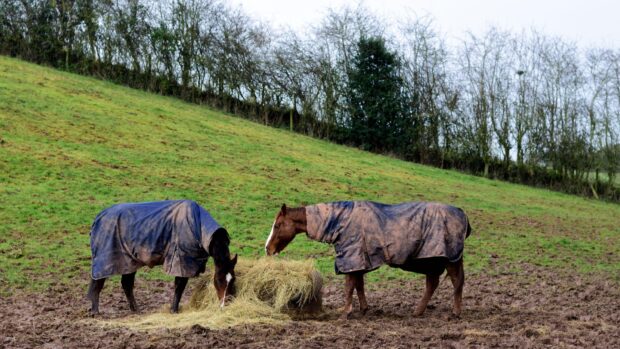During the winter months the dark nights and mornings make even simple tasks seem to take twice as long, while the unpredictable weather can provide working riders with a real headache. But with a bit of careful planning and a flexible routine you can make sure that your horse doesn’t suffer.
Grass kept horses
A well-fitting New Zealand rug helps keep grass-kept horses and ponies warm and dry. When buying a new rug remember, you get what you pay for. More expensive rugs are likely to fit better giving greater protection.
Less grooming helps grass-kept horses retain the natural oil in their coats. Concentrate on removing mud from the belly, saddle areas and head, otherwise tack will rub mud into the skin and sores may develop.
Look out for mud fever and cracked heels. If mud fever does strike, then clean the limbs and dry them carefully. Applying a barrier cream may help prevent the condition from occuring in the first place.
Feet need to be picked out everyday. Impacted mud can cause foot infections and loose shoes.
If it’s very cold, break through the ice on troughs twice a day. Floating a rubber ball in water troughs can help stop the water from freezing over.
Remove leaves and debris on windy days.
Avoid feeding hay in gateways and along fence lines. This will help prevent these areas getting poached. Instead, pile it in a sheltered area of the field. To avoid arguments, put out more piles of hay than there are mouths to feed.
Do not cut back hay rations if the weather improves – the grass will have very little nutritional value.
Raise the comfort factor and increase the warming, energy-giving value of hard feed by dividing the feed ration into three smaller feeds to be given throughout the day. But avoid leaving plastic buckets lying around, because they can shatter in the frost.
Fields with banks, walls and trees or stout hedges will provide some natural shelter from wind and rain but often this is not enough. If you feel your horse’s field does not give adequate protection, consider putting up a simple wind break or field shelter.
The stabled horse
If turning your horse out during the day becomes difficult, why not allow the horse 10 to 15 minutes in the field while you are mucking out. This will help relieve boredom and prevent stable vices from developing.
Heated stables may seem like a luxury, but an infra-red light can make all the difference. The light can be left on with the stable door shut when horses are out of the stable, providing a warm environment when they return.
While many riders use exercise sheets when hacking out clipped horses during the winter, using them when schooling is also a sensible idea.
Horses should be warmed up gradually in cold weather, so the muscles have a chance to loosen up before any demanding work is asked. This will help to prevent the horse from tying up.
Equally after work, the horse must be cooled down slowly. Muscles that have been worked hard may cramp up if a horse is allowed to get cold.
If the exercise programme is cut back drastically through ice and snow, the hard feed ration will need to be reduced to avoid azoturia (tying up) and colic. Most experts recommend removing hard feed from the diet altogether or cutting right back to a single feed and providing hay ad lib.
Just as people benefit from a boost to their immune system in winter, so do horses. Garlic (fed in powder form) is commonly used to help keep bugs at bay.
A slippery problem
Supplies of pure salt, which can be brought from cash and carry stores in bulk, should be readily available to stop the yard from becoming a skating rink.
Harrowing salt into outdoor schools also help prevent them from freezing.
Some yards muck out straight onto the yard (having first removed droppings) when snow or ice bound. This helps to melt the ice and makes it safer to lead the horses out.
Make sure your tack is well oiled to stop it cracking in the cold. Some heating in the tack room will also help keep the leather supple.



